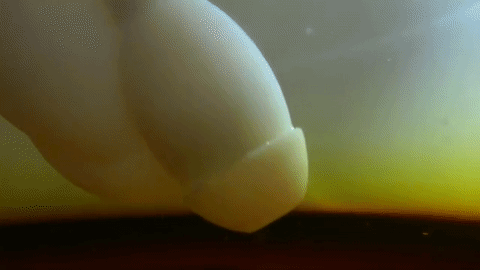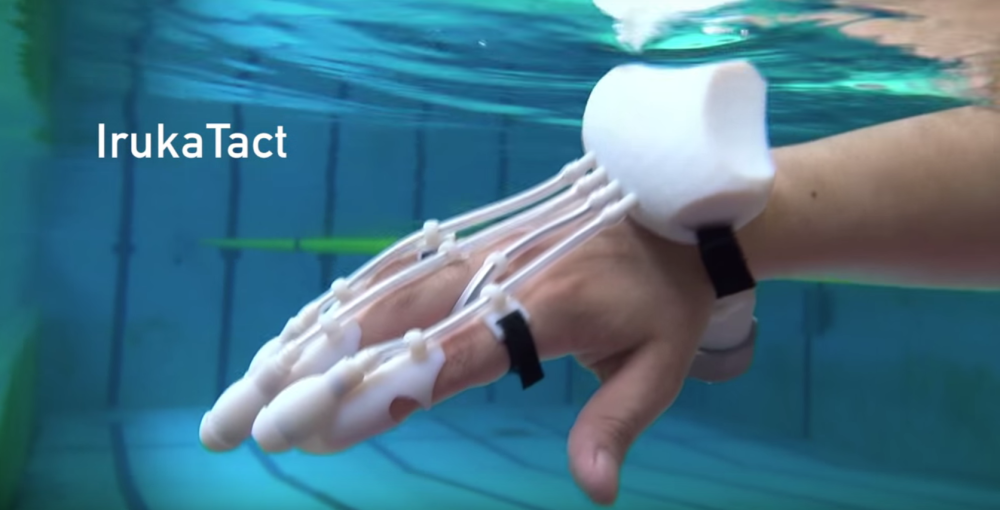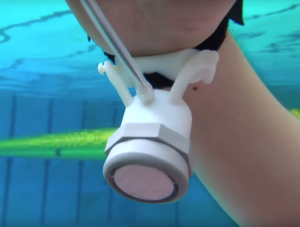This Submersible 3D Printed Haptic Sonar Glove Lets You Feel Things Underwater Without Actually Touching Them
The concept behind haptic communication is quite simple, however the science that makes it possible is much more complicated. The basic process involves the simulation of a sense of touch and tactile contact using vibrations or air pressure being placed on or against a person’s body. The difficulties in making haptic technology work are in controlling the amount of stimulation so it will more precisely mimic the pressure placed on the body when it is touching a real object. The technology has uses as diverse as virtual reality, tactile electronic displays used by the sight impaired, tracking pads on laptops that respond to being touched and even the synced vibrations on modern video game controllers that help further immerse the player in the game.
 Aisen Carolina Chacin and Takeshi Oozu, a pair of PhD candidates from the Empowerment Informatics program at Tsukuba University in Japan, have developed a haptic sonar glove that will allow wearers to feel objects underwater that are just out of their reach. The IrukaTact (‘iruka’ means ‘dolphin’ in Japanese) glove uses echolocation to detect these underwater objects using pulsing micro-jets of water that generate haptic feedback to the person wearing it. The design pulls water in from its surrounding area and directs the jets of water on the wearer’s fingers. Water jets will increase in strength the closer that the glove gets to the object, and weaken if the glove moves away from the object.
Aisen Carolina Chacin and Takeshi Oozu, a pair of PhD candidates from the Empowerment Informatics program at Tsukuba University in Japan, have developed a haptic sonar glove that will allow wearers to feel objects underwater that are just out of their reach. The IrukaTact (‘iruka’ means ‘dolphin’ in Japanese) glove uses echolocation to detect these underwater objects using pulsing micro-jets of water that generate haptic feedback to the person wearing it. The design pulls water in from its surrounding area and directs the jets of water on the wearer’s fingers. Water jets will increase in strength the closer that the glove gets to the object, and weaken if the glove moves away from the object.
“The IrukaTact search glove is an opensource flooding aid kit with the potential to assist people in emergency situations. It was initially conceived as a novel approach to expanding haptic sensations by using the viscosity of aqueous environments to provide more force feedback than in air while consuming less power,” Chacin explained. “This probe translates ultrasonic range finding data to haptic feedback by mimicking the sonar echolocation method used by dolphins (iruka) to sense their surroundings under limited visibility. It extends the sense of touch to feel the topography of a sunken floor in parallel to the wearer’s hand in order to perceive objects under cloudy waters where sight is no longer useful. This project was developed with the guidance of Ars Electronica’s FutureLab to be exhibited as an assistive toolkit at the 2015 Post-City festival.”
IrukaTact uses an advanced ultrasonic device called an MaxBotix MB7066 that uses an Arduino Pro Mini to direct the carefully controlled jets of water. The motors are stored within silicone finger tips that are worn on the index finger, middle finger, and the ring finger, leaving the thumb and pinky finger left free to reduce power consumption and bulk. The control wires that connect the MaxBotix sonar sensor located under the palm and wrist to the small motors on the fingers are all encased within small tubes to keep them watertight. Because the glove has only a very minimal amount of bulk to it, the wearer can easily grasp objects once they have been located.
Currently the IrukaTact can sense objects about two feet away when underwater, however Chacin and Oozu are confident that they can extend that range. While the glove is primarily a research tool that is being used to improve the quality of haptic technology, there are obvious real world uses. Divers could potentially use the gloves to search for objects on the ocean floor under low-light conditions and rescue teams could use them to search for survivors in flood conditions. And naturally a similar glove outfitted with gyroscopes and accelerometers could easily be paired with a VR device like Oculus Rift to provide convincing haptic feedback.
“Our overall goal was to expand haptics. How can you feel different textures or sense depth without actually touching the object? Vibration alone doesn’t cut it for me, or most people, for that matter,” explained Chacin.
Here is some video of the IrukaTact glove in action:
Chacin and Oozu have teamed up with with Ars Electronica to make the 3D printable files and construction instructions for the IrukaTact glove available for download from TinkerCad. By having access to a 3D printer and purchasing a sonar sensor, microcontroller and small motors anyone could potentially build their very own haptic communication water glove. Not only do they encourage further development of the glove, but they hope that it can find use in practical scenarios. Discuss this story in the 3D Printed Sonar Glove forum thread on 3DPB.com.
Subscribe to Our Email Newsletter
Stay up-to-date on all the latest news from the 3D printing industry and receive information and offers from third party vendors.
You May Also Like
Printing Money Episode 17: Recent 3D Printing Deals, with Alex Kingsbury
Printing Money is back with Episode 17! Our host, NewCap Partners‘ Danny Piper, is joined by Alex Kingsbury for this episode, so you can prepare yourself for smart coverage laced...
Insights from Cantor Fitzgerald on AM’s Q1 2024 Landscape
A recent survey by Cantor Fitzgerald sheds light on the persistent challenges within the additive manufacturing (AM) industry in the first quarter of 2024. Based on responses from 38 industry...
3D Printing Financials: Xometry’s Scaling up and Strong Start to 2024
Xometry (Nasdaq: XMTR) kicked off 2024 with strong results, boosting its marketplace and technology to new heights. Both revenue and gross margin soared, fueled by an expanding global network of...
3D Printing Financials: Desktop Metal Targets Recovery Amid Net Losses and Revenue Downturn
Despite facing a decline in revenue and the persistent challenges of a tight economic climate, Desktop Metal (NYSE: DM) is making strides toward operational efficiency. The first quarter of 2024...


































